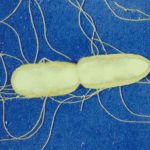Lien vers Pubmed [PMID] – 30808442
Lien DOI – 10.2807/1560-7917.ES.2019.24.8.1800068
Euro Surveill. 2019 Feb; 24(8):
IntroductionHaemolytic uraemic syndrome (HUS) related to Shiga toxin-producing Escherichia coli (STEC) is the leading cause of acute renal failure in young children. In France, HUS surveillance in children aged < 15 years was implemented starting from 1996.AimWe present the results of this surveillance between 2007 and 2016.MethodsA voluntary nationwide network of 32 paediatric departments notifies cases. Two national reference centres perform microbiological STEC confirmation.ResultsOver the study period, the paediatric HUS incidence rate (IR) was 1.0 per 100,000 children-years, with a median of 116 cases/year. In 2011, IR peaked at 1.3 per 100,000 children-years, and decreased to 1.0 per 100,000 children-years in 2016. STEC O157 associated HUS peaked at 37 cases in 2011 and decreased to seven cases in 2016. Cases of STEC O26-associated HUS have increased since 2010 and STEC O80 associated HUS has emerged since 2012, with 28 and 18 cases respectively reported in 2016. Four STEC-HUS food-borne outbreaks were detected (three STEC O157 linked to ground beef and raw-milk cheese and one STEC O104 linked to fenugreek sprouts). In addition, two outbreaks related to person-to-person transmission occurred in distinct kindergartens (STEC O111 and O26).ConclusionsNo major changes in HUS IRs were observed over the study period of 10 years. However, changes in the STEC serogroups over time and the outbreaks detected argue for continuing epidemiological and microbiological surveillance.


